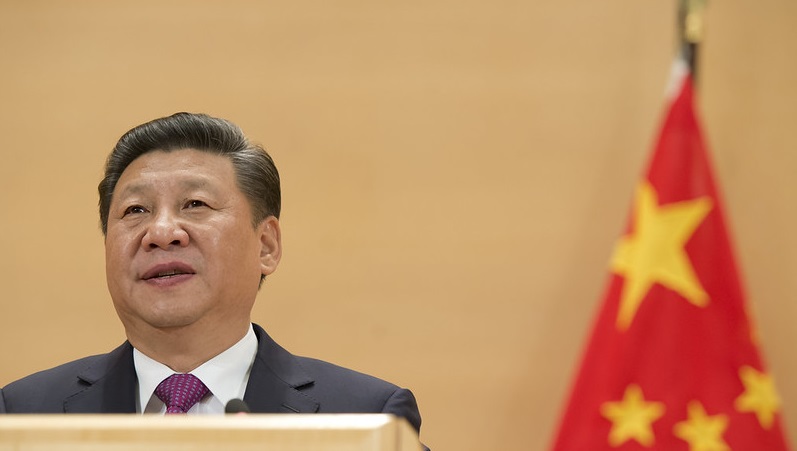China has raised clean energy among the priorities of its flagship international investment programme, while promising an extra $100 billion in development funding.
President Xi Jinping said China will “further deepen cooperation” in green infrastructure and energy projects with developing countries as part of a reboot of the Belt and Road Initiative (BRI).
Xi unveiled his plans at a glitzy summit celebrating the ten-year anniversary of the infrastructure-focused initiative, which has built power plants, roads, and railways around the world and extended China’s sphere of influence in over a hundred emerging economies.
It has also faced accusations of pushing low-income borrowers into unsustainable debt.
‘Smaller and greener’
The revamp will attempt to breathe new life into the initiative after a lull. Lending levels plummeted over the last couple of years as a result of the Covid-19 pandemic and China’s internal economic troubles.
Now Beijing wants to make the Belt and Road smaller and greener, shifting the focus away from colossal and polluting projects and into high-tech and clean energy.
Africa and India push rich nations to phase out fossil fuels faster
Dimitri de Boer, regional director for Asia at ClientEarth, said the summit reinforced the idea that “green is the base colour” of the BRI. “There is a major opportunity here for advancing the global energy transition to mitigate climate change,” he told Climate Home.
Chatham House’s Bernice Lee says the real litmus test is whether the updated Belt and Road can support multiple objectives, beyond simply economic growth. “It is helpful that at a time when so many countries cut their aid spending someone is putting more into the pot, even though the proof is in the pudding as to whether it delivers long-term, lasting benefits”, she added.
The green pivot is not an overnight move and comes two years after Xi pledged China would stop building coal power plants overseas.
Clean energy pivot
Fossil fuel infrastructure had absorbed nearly two-thirds of the energy-related funding committed through the Belt and Road up until then. Dozens of coal plants were built in countries like Indonesia, Pakistan and Vietnam, locking in carbon-intensive energy production for potentially decades.
According to an analysis by Boston University, Chinese-financed power plants emit more than 245 million tons of CO2 each year – roughly equivalent to Spain’s annual carbon footprint.
Since Xi’s 2021 promise, however, no new coal plants have been developed and investment in renewables has taken off. In the first half of 2023, solar, wind and hydro took up about 55% of energy-related construction and investment facilitated by the Belt and Road, according to Beijing-based Green Finance and Development Centre.
Observers hope the trend will continue, as China pumps cash into its overseas investment programme. Xi said on Wednesday 780 billion yuan ($106 billion) will be made available through Chinese-backed development banks to support Belt and Road projects.
JETP rival
Beijing has also announced the launch of a clean energy initiative seen as China’s response to the Just Energy Transition Partnerships (JETPs) struck up by rich Western nations and South Africa, Indonesia, Vietnam and Senegal.
Few details about the Green Investment and Finance Partnership (GIFP) have been revealed and no concrete deals have been announced. But Boston University’s Kevin Gallagher, who attended the summit, told Climate Home that the focus will be on “green energy pathways” and not on decommissioning existing fossil fuel plants, like in the Jetp.
Polish election result improves prospects for EU climate ambition
He added the programme will enable partner countries to receive technical assistance on project design and investment from a consortium of participating Chinese financial institutions.
“Beijing’s initiatives are a complement, not an alternative, but hopefully they will spark healthy competition,” said Gallagher. “The JETPs have had trouble getting off the ground and developing countries worry they will accentuate debt burdens. It remains to be seen if GIFPs can be cheaper and faster.”
Vulnerable countries watching
The plans are being watched with interest by emerging and low-income economies that struggle to access the level of finance needed to clean up their energy systems.
Attended by representatives from 130 countries, largely from the Global South, the summit saw repeated appeals from leaders of climate-vulnerable nations for more money to fund climate action.
Sara Jane Ahmed, who represented the V20 coalition of vulnerable nations in Beijing, said the group can work more closely with China through a “green” Belt and Road. “China has launched a program that will truly matter,” she told Climate Home. “What we are seeing more clearly from China is a recognition of collective gains and of shared prosperity aims and this is being driven by technology leaders and long-term partners.”
No talks of ‘climate’
Amid all the green rhetoric, one word remained largely absent from any of the speeches made by the Chinese leadership in relation to finance: climate.
This is no accident, says Li Shuo, global policy advisor for Greepeace East Asia. “China certainly see some of its Belt and Road projects as contributing to the world’s decarbonisation efforts. But it won’t label them as climate finance, so that it is not in any way confused as a potential Chinese contribution to UNFCCC climate finance targets,” he added.
The provision of UN-mandated climate finance has become an increasingly thorny issue. While developed nations have not yet delivered on a pledge to provide $100 billion in climate finance annually by 2020, they are increasingly pushing to expand the donor base beyond historical polluters.
China strongly maintains that it is the responsibility of developed countries to provide climate finance labeled as such.
